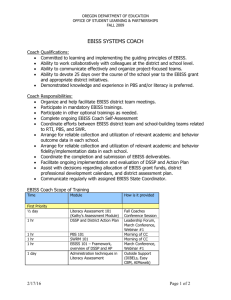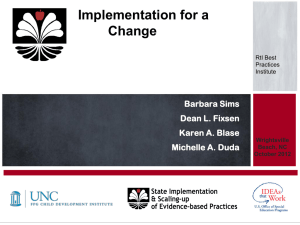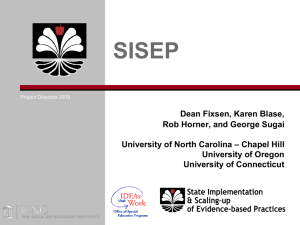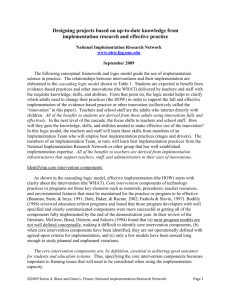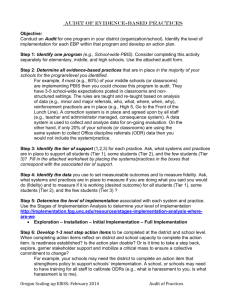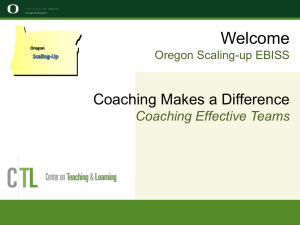Powerpoint.EBISS.August2013
advertisement
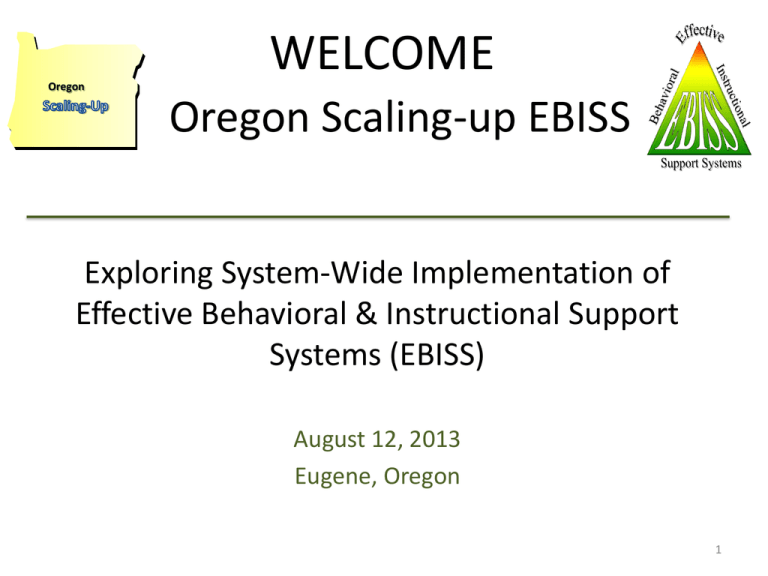
Oregon WELCOME Oregon Scaling-up EBISS Exploring System-Wide Implementation of Effective Behavioral & Instructional Support Systems (EBISS) August 12, 2013 Eugene, Oregon 1 Introductions Martha Buenrostro, Ph.D. Oregon Department of Education Erin Chaparro, Ph.D. & Kathleen Ryan Jackson Center on Teaching and Learning Amy Gaumer Erickson, Ph.D. & Pattie Noonan, Ph.D. University of Kansas Marick Tedesco, Ph.D. & Kimberly Ingram-West, Ph.D. State Transformation Specialists 2 Oregon Scaling Up EBISS http://www.ode.state.or.us/initiatives/idea/education-update-july-2013.pdf 3 ! ! !! Oregon!Scaling-up! EBISS! ! O ! Activity!Booklet! August!12,!2012! ! 4 Reflection & Learning from One Another 1. Think: Think independently about the question that has been posed, forming ideas on your own (3 minutes). 2. Pair: Discuss your thoughts with your team or table partners. Consider the thoughts of others (5-20 minutes). 3. Share: Teams or tables take turns sharing their ideas with audience (3-5 minutes). 5 “All Students a Graduate” http://oregonrti.org/node/74 6 How can a districtwide focus on “building the reading skills student’s are missing from the past” ensure all students will meet 4040-20 by the year 2025? 7 Learning Objective 1 Understand critical features of implementing tiered models of support for behavior and literacy to support all students – All have access to quality core instruction – Universal screening & progress monitoring system – Small group and individualized support for some and a few – Data teaming framework for action planning and on-going evaluation 8 Learning Objective 2 Apply the basic principles of Implementation Science – Develop the vocabulary of Implementation Science – Integrate Implementation Frameworks across all initiatives – Engage in activities to strengthen your understanding of how to effectively implement tiered models of support 9 Outcome Develop the foundational skills to ensure your district vision and district-wide practices align within a common district framework 10 Oregon Scaling-up EBISS Professional Development District Commitment • Attend 3 Live Trainings with a representative team of district leaders • Participate in Live and recorded Webinars • Relay information to your district leadership team and board to determine what it would be like to implement EBISS in your district Oregon 11 CTL’s Commitment to You Three full day Live Trainings 20 follow-up webinars (30-45 minutes) August 12, 2012 Live Training • • 5 Pre-recorded webinars (available September 1st) 3 Pre-recorded training videos (supplemental) February 05, 2013 Live Training • 5 Pre-recorded webinars (available Feb. 20) April 15, 2013 Live Training • 7 Pre-recorded webinars (available April 21) plus 2 supplemental EBISS Scaling-up Blog • Calendar of events and resources http://blogs.uoregon.edu/oregonscalingupebissblog/ Goals for Today 1. Provide an overview of the critical features of Effective Behavioral and Instructional Support Systems (EBISS) 2. Reflect upon your district’s beliefs and collective commitment to a culture of achievement for all 3. Introduce key concepts of Implementation Science 4. Preview next steps 13 District Background Activity Please Complete the on-Line Survey https://oregon.qualtrics.com/SE/?SID=SV_e33AUkZw9MmWtVj There is nothing more important to our country’s future than the education we give our children. -President Obama We need you to believe in us …. http://www.youtube.com/watch?v=HAMLOnSNwzA Our beliefs are shaped by our experiences, these beliefs can place contingencies on what we believe students can do. Youth can experience a sense of alienation and powerlessness when they are judged or reduced to something about their identity. PYhttp://www.youtube.com/watch?v=PY9ESojSw7Y Do you believe all students can achieve their potential? • Do your experiences place contingencies on this belief? • Are there contingencies that your colleagues or district places on this belief? • If so what are they? 19 Blending Literacy and Behavior in a Tiered Model of Support http://www.ode.state.or.us/search/page/?=2347 20 EBISS GOALS 1. Teach district leaders how to implement a tiered model of PBIS and the school-wide reading model system-wide Data – Systems – Practices – Outcomes 2. Increase equitable use of district and building resources for tiered models of support Recourse Allocation Based on Need 3. Develop capacity for high-quality, sustainable implementation of evidence-based practices Distributed Leadership 21 26 School Districts: 2006-2012 22 Integrated System of Student Achievement Drawing by Stacy Goodman State Implementation & Scaling-up of Evidence-based Practices 23 “We don’t have a lot of kids who fall through the cracks anymore.” http://oregonrti.org/node/74 24 What could be driving this level of … • student achievement? • principal and teacher satisfaction in a school? • In a district? Identify 3-4 variables that you think could account for this level of achievement and satisfaction. 25 Critical Components of EBISS 26 Tiered Models of Support It is not just another initiative… • It is a long term commitment to system-wide change through a common framework. • It requires continuous analysis of data, systems and practices to promote continuous and sustainable improvement. Implementing tiered models of support requires a belief that all students can reach their potential when given the required support. 27 EBISS Teaming Framework 1. Representative District and Building Leadership Implementation Teams 2. Evidence-based Practices 3. Improvement Cycles & Communication Loops 4. Systems Level Assessment EBISS Teaming Framework 29 Critical Component #1 District & Building Leadership Implementation Teams INTERVENTION District & Building Leadership Implementation Teams Effective Implementation Team 80% in 3 Yrs Effective use of Implementation Science & Practice Fixsen, Blase, Timbers, & Wolf, 2001 NO Implementation Team 14% in 17 Yrs Letting it Happen Hoping it Happens Balas & Boren, 2000 31 Implementation Team • A group that knows the evidence-based practices very well (formal and craft knowledge) • A group that knows implementation very well (formal and craft knowledge) • A group that knows improvement cycles to make intervention and implementation methods more effective and efficient over time © Fixsen & Blase 32 Implementation Team • Minimum of three people (four or five preferred) to promote effective, efficient, sustainable implementation, organization change, and system transformation work • Tolerate turnover even when the players come and go - teams are sustainable © Fixsen & Blase 33 EBISS Critical Component #2 Evidence-based Practices Evidence-based Practice • Systematic, empirical methods draw on observation or experiment • Rigorous data analyses to test the hypotheses and justify the general conclusions • Multiple measurements provide valid data • Peer-reviewed by a panel of independent experts through rigorous, objective, and scientific review What Works Clearing House: http://ies.ed.gov/ncee/wwc/ EBISS Critical Component #3 Improvement Cycles Communication Loops Improvement Cycles Purposeful process for change – Education is not static • Varied cohorts of students, teachers, & leaders • Shifting socio-political influences at the local, district, state and national level Systems – Today’s solutions become tomorrow’s problems • Understand the strengths of our systems • Change to support contextual needs Communication Loops – Practice Informs Policy & Policy Enables Practice 37 EBISS TEAMING FRAMEWORK Revised September, 2012 38 Central Office Transformation Linking performance of central office staff to teaching and learning outcomes Wallace Foundation, April, 2010 • District became experts in the specific needs, strengths, goals and context of each school • Shift from delivering services to – Problem solving – Using resources across multiple central office departments 39 Alignment Vision and practices align within a common district framework “Implementation of all initiatives fit into the EBIS Framework“ - Sally Helton, TTSD “Doing this well implies changes in everyone’s practice in the central office, not in just what teachers or principals do” EdWeek Update: Job Roles Shifting for Districts' Central Offices, July 17, 2012 40 Rob Saxton, Deputy Superintendent of Instruction , ODE “You have to get through the SHIFT to appreciate how the resources work.” http://oregonrti.org/node/74 41 “You have to get through the SHIFT to appreciate how the resources work.” • How many initiatives and practices in your district align within one common implementation framework? • What would it take to make this shift? 42 43 Improvement Cycles Communication Loops 3 Elementary Schools 2 Middle Schools - 1 High School 44 Improvement Cycles Communication Loops 45 Leaders Have to be There Meta Analysis of 27 studies • Establishing goals and expectations: .42 • Resourcing strategically: .31 • Planning, coordinating, evaluating teaching and the curriculum: .42 • Leaders promoting and participating in teacher learning and development: .84 • Ensuring an orderly and supportive environment: .27 Robinson, Lloyd & Rowe, 2008 46 “It’s important if the leader is there” http://oregonrti.org/node/74 47 Are principals always present at data team meetings in your district? • Do principals have a deep knowledge of the district’s EBP’s in order to fully participate and guide instructional decisions? • Knowledge to meet SB290 guidelines for best practice evaluation and support systems? 48 EBISS: Whole System Reform District and Building Leadership Implementation Teams • Crystal clear focus, direction and target Build Capacity from Day One • Same focused goals, same language • Distributive Leadership, leaders developing leaders Developing a Strong System of Schools • Not one or two strong schools Chaparro (2012), Fullan (2010), Harris (2008), Spillane (2012) EBISS Teaming Framework 50 EBISS Critical Component #4 District Systems Support Plan (DSSP) Systems Level Assessment VISIBILITY & POLITICAL STAKEHOLDER SUPPORT FUNDING ON-GOING ASSESMENT & EVALUATION PROFESSIOANL DEVELOPMENT & TRAINING CAPACITY COORDINATION & COACHING ACTION PLANNING with SCHOOLS LEADERSHIP & COMMITMENT Systems Level Assessment Critical Variables for Program-Wide Infrastructure Data for Action Planning and OnGoing Evaluation 52 Average DSSP Scores Across all EBISS Districts 100 Percentage of features in place 90 83 86 84 83 82 78 80 80 73 70 74 80 72 72 70 72 64 70 60 74 73 67 62 2008-2009 60 64 60 58 57 53 50 50 40 39 20 10 0 2009-2010 53 2010-2011 47 30 70 63 2011-2012 District Reflections Leadership and Commitment District & Building Implementation Teams developed – Shared resources, knowledge & common goals – Set guidelines for implementation to meet clearly defined outcomes “We never met as a team and discussed our common goals…now we set action items that compliment all of our programs and services.” “Implementation is not an option, but we will get you the supports you need to be successful.” – Hiring practices, training calendar, EBPs, a strategic plan to work with schools and sites 54 Have EBISS Schools Increased Their Implementation of Behavior Systems? 99 100 96 91 90 80 96 91 95 94 93 99 90 95 92 83 82 85 89 76 81 70 72 72 60 Year 2 2007-08 50 Year 3 2008-09 Year 4 2009-10 40 Year 5 2010-11 30 20 10 0 Behavior leadership team in place Behavior support model in place Behavior data system Behavior action plan in place in place SET or BoQ District Reflections Organizational Supports: Develop institutional capacity to support all staff On-going Assessment & Evaluation to break down barriers Action Planning with schools “Our EBISS leadership team meets regularly to look at our DSSP goals…we are looking at data regularly…what a difference it makes…we see what we need to re-train and where we need to coach…to meet our outcomes” – Analysis of data for problem solving and action planning - resources and support are differentiated 56 Have EBISS Schools Increased Their Implementation of Literacy Systems? 99 100 100 98 97 95 92 93 90 99 95 92 83 90 82 87 85 80 75 70 73 71 Year 3 2008-09 Year 4 2009-10 60 50 Year 5 2010-11 54 40 30 Year 2 2007-08 31 20 10 0 Literacy leadership Tiered literacy model Literacy screening Literacy progress Literacy action plan team in place in place system in place monitoring system in in place place Oregon Assessment of Knowledge and Skills Changes Across 4 Years 3rd Grade 07-08 08-09 09-10 10-11 Met 49.3 52.9 51.5 49.5 Exceeded 35.5 30.9 33.9 33.6 4th Grade 07-08 08-09 09-10 10-11 Met 45.5 46.4 45.8 46.3 Exceeded 39.1 39.0 39.7 38.1 5th Grade 07-08 08-09 09-10 10-11 Met 50.1 51.9 52.9 53.2 Exceeded 25.4 25.3 25.4 24.8 Rob Saxton, Deputy Superintendent of Instruction , ODE “We are starting to knock the socks off it” http://oregonrti.org/node/74 59 What level of engagement do you think this superintendent and board have with school level data? • Data on student achievement, teacher skills, and resource allocation based on the unique needs of schools? 60 District Reflections Staff Competency: The Fundamental Building Block to Sustainability Coordination and Coaching Professional Development & Training Non-EBISS Program Coordinator “We start with good intentions but we never seem to fit it (coaching) into our schedules, how do you fit it into your schedule?” EBISS Coach “Our administration is dedicated to the process of coaching everything we train, we develop a training and coaching calendar for the year and she makes sure we strict to it.” “We also use video coaching.” (EBISS coach) 61 District Reflections Establishing Buy-in Funding, Visibility & Political Stakeholder Support EBISS System Coach “Semi-annual presentations about our goals and progress really helps to show our stakeholders that we are making progress…their money is well spent…so they will continue to support our work.” – Easy to read data, sharing success, presenting a compelling reason to fund an initiative 62 Why EBISS & Tiered Models of Support? 63 The Mathew Effect ……the rich get richer and the poor get poorer Stanovich, 1986 When children fail at early reading and writing – They begin to dislike reading – They read less – They learn less from reading The consequence – They do not gain vocabulary – They do not gain background knowledge, and information about how reading material is structured http://www.youtube.com/watch?v=lF6VKmMVWEc 64 A Tale of Two Students 87% 88% Juel, C. (1988). Learning to read and write: A longitudinal study of 54 children from first through fourth grades. Journal of Educational Psychology, 80, 437-447. 65 Commonalities of RTI, SWRM, PBIS, EBPs Component RTI SWRM PBIS Any EBP Tiered Systems of Support Prevention Orientation Research Validated Interventions programs and intensity when necessary Universal Screening System Progress Monitoring System Data-based decision making System level problem identification and solution Student level problem identification and solution Alternative special education eligibility determination Response to Instruction: Tier 1 Evidence based universal program • Contextual fit for student demographics High quality instruction for all students • • • Differentiated instruction based on assessment Focus on essential skills and evidence-based strategies Explicit, systematic instruction • • • Modeling, opportunity to respond, immediate corrective feedback Monitor progress regularly Opportunities to practice and apply skills across cognitive domains • Flexible instructional groupings Response to Intervention: Tier 2 Screening measure identifies students at-risk • Evidence-based instruction supplements Tier 1 universal instruction • Small group instruction • Frequent progress monitoring • Fidelity to implementation research 68 Response to Intervention: Tier 3 Students who do not respond to Tier 2 instruction and intervention modifications require • Individual, intensive, instructional intervention • Specialists or specially trained professionals • Frequent progress monitoring Does not assume that students are referred to or are currently in special education • Tier 3 may be needed due to environmental factors and previous lack of access to appropriate instruction “Is there something else we can do to help this child bloom.” http://oregonrti.org/node/74 70 The Shift District vision and all district-wide systems and practices align within a common district framework 71 It is not going to be the way “it” was... We are not sure what “it” will look like… That leaves us uncertain… 72 Change Arouses Emotions Michael Fullan, 2001 73 Managing Complex Change Adapted from Knoster, T., Villa, R., & Thousand, J. (2000). A framework for thinking about systems change. In R. Villa & J. Thousands. (Eds.). Restructuring for caring and effective education: Piecing the puzzle together. (pp. 93-128). Baltimore: Paul H. Brookes Publishing Co. 74 Establish the Vision What you do simply proves what you believe -Sinek What practices are in place to make your district vision true for every student? -Reeves Effective Boards clearly articulate, regularly to all stakeholders, their belief that all students can achieve. -Johnson 75 Why Do You Exist? Simon Seink: http://www.ted.com/talks/simon_sinek_how_great_leaders_inspire_action.html 76 What you do simply proves what you believe. -Sinek Mission: What is your purpose? Vision: What will come to be? • What behaviors and actions does your district need to strengthen or develop to make your mission and vision true for every student? 77 78 Evaluation Tools and Timeline Pattie Noonan, Ph.D. 79 Oregon Scaling-Up EBISS 80 Integrated System of Student Achievement Drawing by Stacy Goodman State Implementation & Scaling-up of Evidence-based Practices 81 The role of the SISEP Center is to build the capacity of state education systems to implement and scale up effective education innovations statewide, so that every student can benefit from the intended outcomes. http://sisep.fpg.unc.edu/ 82 Implementation Science 101 Integrating Science and Practice • The research on what is effective evidence-based practice (EBP) • The research on how to implement any EBP, as it was designed, to benefit every student 83 Why is Implementation So Important? Good Intentions Actual Supports Years 1-3 Outcomes Every Teacher Trained Fewer than 50% of the teachers received some training Fewer than 10% of the schools used the practice as designed Every Teacher Continually Supported Fewer than 25% of the teachers received support Vast majority of students did not benefit Comprehensive School Reform: Aladjem & Borman, 2006; Vernez, Karam, Mariano, & DeMartini, 2006 Implementation Science The Implementation Team • Knows-WHAT –Knowledge of the intervention • Knows-HOW –Knowledge of implementation Tucker, Edmondson, & Nembhard (2005) 85 WHAT: Evidence Based Practice Fit – Feasibility – Willingness – Readiness 1. Systematic, empirical methods 2. Rigorous data analysis 3. Justify the general conclusions 4. Valid data through multiple measurements 5. Peer-reviewed by a panel of independent experts • Rigorous, objective, and scientific review National Institute for Literacy, 2006 What Works Clearing House: http://ies.ed.gov/ncee/wwc/ 86 Reflect: What & How 3rd Grade Reading Data • OAKS outcome data • Survey implementation data Do you have a Gap? Where? What variables could be related to the Gap? 87 HOW: 4 Implementation Frameworks 1. Implementation Teams 1. Improvement Cycles 2. Implementation Stages 3. Implementation Drivers 1. Implementation Teams Oregon Who Will Do What Differently? Who Will Help Change Occur? http://sisep.fpg.unc.edu Practice Informs Policy & Policy Enables Practice 89 2. Improvement Cycles Plan-Do-Study-Act 1. Plans are clarified (Plan) What is the desired outcome? 2. Plans are carried out as intended (Do) What is the fidelity of implementation plan? 3. The results are examined (Study) On-going evaluation 4. Actions are taken to improve the plan (Act) Plans are reviewed and modified as needed on a regular basis. Process is repeated until exemplary outcomes are obtained. http://sisep.fpg.unc.edu 90 3. Stages of Implementation Major Implementation Initiatives occur in stages: • • • • Exploration Installation Initial Implementation Full Implementation Full implementation can take up to four years under optimal conditions Fixsen, Naoom, Blase, Friedman, & Wallace, 2005 91 HOW: Readiness Readiness 1. A developmental point 2. Capacity and willingness to engage • Critical component at every stage of implementation • Often adaptive leadership must be exercised 92 Exploration Complex Change • In place? • Steps to revisit? 1. Formalize Teaming Structures 2. Determine Need and Identify Options 3. Assess “Fit” and Feasibility 4. Promote “Buy-In” 93 Installation Complex Change • In place? • Steps to revisit? A Decision to Move Forward 1. Active Engagement in “Set-up” • Training and coaching routines defined 2. Leadership Maintains Focus and Momentum • Resources are consumed – but students are not taught differently 94 Initial Implementation ComplexChange Change Complex place? • • InInplace? Stepstotorevisit? revisit? • • Steps 1. Working through awkwardness – Managing change and expectations 2. Providing training and coaching – Reorganizing school roles, functions and structures 3. Improvement cycles resolve systems issues – Rapid problem solving between schools and districts 95 Full Implementation Complex Change • In place? • Steps to revisit? 1. New learning about EBP is integrated at all levels 2. All students benefit from the EBP 3. All staff are supported 4. Data collected and used for decision making 5. Supportive and functional administrative environment 96 First Step To Effective Implementation 1. District & Building Leadership Implementation Team (DLIT & BLIT) • Develop collaborative work processes • Develop a collective commitment • Gather information needed for decision making • Practice Informs Policy (PIP) • Policy Enables Practice (PEP) 97 4. Implementation Drivers Staff Competence Organization Supports Leadership © Fixsen & Blase, 2009 98 Implementation Drivers Activity Identify how your District Implementation Team fulfills the functions and roles it is responsible for within the Implementation Pyramid 1. List every department responsible for Instructional Leadership and code each with a separate color. 1. __________________________ 2. __________________________ 3. __________________________ 4. __________________________ Example Board and Superintendent Curriculum • Student Services • Title and ELD 99 Implementation Drivers Technical Adaptive Leadershi p © Fixsen & Blase, 2009 100 Leadership Technical and Adaptive Technical and adaptive leadership styles are exercised to manage and continually improve the evidence based programs and implementation components to support and sustain high levels of staff performance. © Fixsen & Blase, 2009 Leadership: Technical Technical Leadership is used when there is greater certainty and more substantial agreement about the ‘right’ course of action to pursue – everything fits into the district’s common framework. • Looks more like management (of instruction) • Once established full use of the drivers rely on routine and clear methods that follow clear implementation guidelines “The way we do things here.” 102 Leadership: Adaptive Required when values, philosophies and long-standing ways of work are challenged or found to be ineffective. • Used when there is less certainty and agreement about problems and solutions • Highly interactive and usually involves multiple stakeholders • Groups convene and work to build consensus 103 Hypothetical District 1. Representative team of stakeholders explored the feasibility of implementing EBISS. 2. They made a decision to move forward and implement the SWRM K-3 knowing that: • • • Core curriculum is not used by all Student data varies by classroom and by school Administrators say staff skill varies widely –No protocols for using data to make decisions –No agreement on what differentiation strategies will be used or what fidelity looks like 3. Engaged in Installation Activities 104 Implementation Driver Activity District Leadership Implementation Team Performance Assessment Systems Intervention Coaching Training Selection Board and Superintendent Curriculum • Student Services • Title and ELD • Coaching Support Integrated & Compensatory Facilitative Administration Decision Support Data Systems Leadership Drivers Adaptive & Technical © Fixsen & Blase, 2008 Implementation Drivers Systems Intervention Facilitative Administration Organization Supports Decision Support Data Systems Technical Adaptive Leadership © Fixsen & Blase, 2009 106 Organizational Supports 1. SYSTEMS INTERVENTION: Process to understand level of implementation, identify and remove barriers and strengthen supports 2. FACILITATIVE ADMINISTRATION: Data used to maximize supports - selection, training, coaching and performance assessment 3. DECISION SUPPORT DATA SYSTEMS: Data to evaluate systems, practices, outcomes and set actionable goals (PDSA) © Fixsen & Blase, 2009 107 Implementation Driver Activity District Leadership Implementation Team Performance Assessment Coaching Board and Superintendent Curriculum • Student Services • Title and ELD • Coaching Team Systems Intervention Training Integrated & Compensatory Selection Leadership Drivers Adaptive & Technical Facilitative Administration Decision Support Data Systems © Fixsen & Blase, 2008 Implementation Drivers Performance Assessment (Fidelity) Staff Competence Coaching Training Curriculum • Student Services • Coaching Team Facilitative Administration Selection © Fixsen & Blase, 2009 109 Staff Competence 1. Selection: Willingness to learn and possession of skills required to implement district’s EBPs 2. Training: All staff are taught, re-taught the knowledge and skills required to implement EBPs with fidelity 1. Coaching: Staff are supported at all levels of the system: district & board, school leaders, teachers, para-professionals © Fixsen & Blase, 2009 110 Performance Assessment Improved performance of all staff is the critical outcome • Staff routinely assessed • Constructive feedback provided • Creating supportive environments • Exercising appropriate leadership • Developing a collective commitment to improvement • Meeting SB290 goals © Fixsen & Blase, 2009 111 Performance Assessment, “It is not a negative situation.” http://oregonrti.org/node/74 112 Implementation Driver Activity District Leadership Implementation Team Performance Assessment Board and Superintendent Curriculum • Student Services • Title and ELD • Coaching Team Systems Intervention Coaching Training Integrated & Compensatory Selection Facilitative Administration Decision Support Data Systems Leadership Drivers Adaptive & Technical © Fixsen & Blase, 2008 Driver Reflection Performance Assessment Systems Interven on riv ers Coaching pet Co m or t Selec on Integrated & Compensatory Facilita ve Administra on p up al S enc yD Training on Strengths? Gaps? Overlaps? Other departments needed? iza gan Or • • • • s Leadership Adap ve & Technical Decision Support Data Systems © Fixsen & Blase, 2008 114 Team Activity • What are the clear strengths of your DLIT? • Are there functions that are being neglected (Gaps)? • Are there functions that are overrepresented (Overlaps – yes/no – is it appropriate)? • Are all departments represented in the process? HR? Finance? Other? 115 Putting “It” Into Action • Who will do what differently? • Who will help change occur? • How will change happen? –Change occurs at all levels of the system Board – district School leaders – teachers and students Community – families and stakeholders 116 Next Steps Teams View Recorded Webinars 1. Stages of Implementation: • Focus on Exploration 2. Competency Implementation Drivers: • Facilitators to implementation of your EBP 3. Organizational Implementation Drivers: • What the data says about facilitators and barriers 4. Staff Competency: • The Importance of Performance Assessment 5. Preparation for February 5, 2014 • Putting it all together 117 Questions and Answers Day 1 Resources and References • Provided at the end of this PowerPoint Presentation Materials & Archived Webinars http://blogs.uoregon.edu/oregonscalingupebissblog/ 118 Please Email or Call us with Questions Erin A. Chaparro, Ph.D. echaparr@uoregon.edu 541-346-1103 Kathleen Ryan Jackson kmj@uoregon.edu 541-990-2043 Resources EBISS: http://www.ode.state.or.us/search/page/?=2347 National Center on Response to Intervention: www.rti4success.org Oregon RTI (OrRTI): http://oregonrti.org/node/74 Oregon Scaling Up http://www.ode.state.or.us/search/page/?id=3474 State Implementation & Scaling-up of Evidence-based Practices Center: http://sisep.fpg.unc.edu/ What Works Clearing House: http://ies.ed.gov/ncee/wwc/ Stanovich, 1986 The Matthew Effect http://www.youtube.com/watch?v=lF6VKmMVWEc Behavior: Positive Behavioral Interventions and Support: http://www.pbis.org/ Literacy: Oregon K-12 Literacy Framework: http://www.ode.state.or.us/search/page/?id=2568 Oregon RTI: http://www.ode.state.or.us/search/page/?id=315 Reading next: A vision for action and research in middle and high school literacy http://www.all4ed.org/files/ReadingNext.pdf 120 References Aladjem, D. K., & Borman, K. M. (2006). Examining comprehensive school reform. Washington, DC: Urban Institute Press. Balas, E. A., & Boran, S. A. (2000). Managing clinical knowledge for health care improvement. In J. H. van Bemmel, A. T. McCray & T. Alexa (Ed.), Yearbook of medical informatics: Patient-centered systems (pp. 65–70). Stuttgart, Germany: Schattauer. Chaparro, E. A., Smolkowski, K., Baker, S. K., Hanson, N. & Ryan Jackson, K. M. (2011). A Model for System-Wide Collaboration to Support Integrated Social Behavior and Literacy Evidence-Based Practices. Psychology in the Schools. 49(5), 465-482. Chaparro, E. A., Ryan Jackson, K.M., Baker, S. K., & Smolkowski, K. (2012). Effective Behavioral and Instructional Support Systems: An Integrated Approach to Behavior and Academic Support at the District Level. School Based Mental Health Interventions 5, 161-176. Clements, D.H. (2007). Curriculum research: Toward a Framework for “research-based curricula”. Journal for Research in Mathematics Education, 38, 35-70. Tucker, A.L., Nembhard, I.M., & Edmondson, A.C., (2007). Implementing new practices: An empirical study of organizational learning in hospital intensive care units. Management Science, 53, 894-907. Fixsen, D. L., & Blase, K. (2009). Implementation: The missing link between research and practice NIRN Implementation Brief #1. Chapel Hill, NC: The University of North Carolina, FPG, NIRN. Fixsen, D. L., Blase, K. A., Timbers, G. D., & Wolf, M. M. (2001). In search of program implementation: 792 replications of the TeachingFamily Model. In G. A. Bernfeld, D. P. Farrington & A. W. Leschied (Eds.), Offender rehabilitation in practice: Implementing and evaluating effective programs (pp. 149–166). London: Wiley. Fixsen, D. L., Naoom, S. F., Blase, K., Friedman, R. M., & Wallace, F. (2005). Implementation research: A synthesis of the literature. (FMHI publication No. 231). Tampa, FL: University of South Florida, Louis de la Parte Florida Mental Health Institute, The National Implementation Research Network. 121 References, Cont. Fullan, M. (2010). Motion leadership: The skinny on becoming change savvy. Thousand Oaks, CA: Corwin Press. Heifetz, R.A. & Linsky, M. (2002). Leadership on the line: Staying alive through the dangers of leading. Harvard Business School Press: Boston Honig, M. I., Copland, M. A., Rainey, L., Lorton, J. A., & Newton, M. (2010). Central office transformation for districtwide teaching and learning improvement. Retrieved from The Wallace Foundation website: http://www.wallacefoundation.org/knowledge-center/school-leadership/district-policy-and-practice/Documents/Central-OfficeTransformation-District-Wide-Teaching-and-Learning.pdf Johnson, P. (2010). Leading for learning: Leadership practices of effective boards. ERS Spectrum, 28, 27-42. Robinson, V. M. J., Lloyd, C. A., & Rowe, K. J. (2008). The impact of leadership on student outcomes: an analysis of differential effects of leadership types. Educational Administration Quarterly, 44, 635–674. doi: 10.1177/0013161x08321509 the Vernez, G., Karam, R., Mariano, L. T., & DeMartini, C. (2006). Evaluating comprehensive school reform models at scale: Focus on implementation. RAND Education. Retrieved from http://www.rand.org/pubs/monographs/ 2006/RAND_MG546.pdf 122
